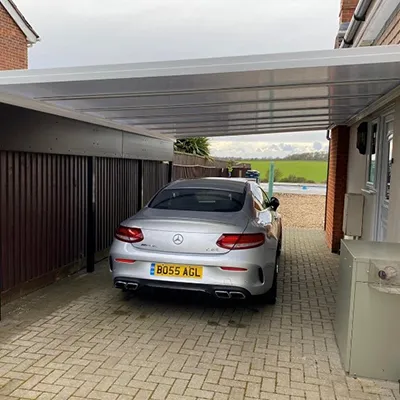The Timeless Elegance of Orangeries in the UK: A Complete Guide to the British Orangeries
The Timeless Elegance of Orangeries in the UK: A Complete Guide to the British Orangeries
Orangeries, with their origins dating back to the Renaissance period, have a rich and fascinating history in the UK. Initially designed as grand structures to protect exotic citrus trees from the harsh winter climate, they soon became symbols of wealth and status among the elite. Over the centuries, these elegant buildings evolved from mere practical conservatories to luxurious spaces for social gatherings and leisure.
An orangery is essentially a room or a building with large windows, typically featuring a glass roof or sections of it, built to house and nurture tender plants. Unlike greenhouses, orangeries are more substantial and are often integrated into the main building, offering a seamless blend of indoor and outdoor living.
In this blog, we’ll explore the journey of orangeries from their historical origins to their modern-day applications. We’ll delve into architectural features, design trends, and practical considerations for building and maintaining your orangery. Join us as we uncover the timeless elegance and functionality of these magnificent structures.

The Origin and Evolution of Orangeries
- Early Origins in Renaissance Italy: Orangeries first emerged in the 16th century in Italy, designed as grand structures to house exotic citrus trees. These buildings were a testament to the luxury and sophistication, favoured by the Italian nobility.
- Adoption in France and the UK: The allure of orangeries spread to France, becoming a staple in the gardens of the French aristocracy. By the late 17th century, they made their way to the UK, embraced by British nobility as symbols of wealth and status.
Evolution Through the Centuries
- 17th and 18th Centuries: Symbols of Wealth and Status: In the UK, orangeries were grand structures with large, tall windows and glass roofs, designed to maximise sunlight for the delicate citrus trees. These buildings were a display of affluence and refinement.
- 19th Century: Transition to a More Functional Space: With advancements in glass production and heating systems, orangeries became more functional, serving as luxurious extensions of the living space for entertaining guests or enjoying a tranquil retreat.
- Modern-Day Orangeries: Fusion of Tradition and Contemporary Design: Today, orangeries blend traditional elegance with modern functionality. They serve as versatile spaces such as dining rooms, living areas, or home offices, retaining their classic features while incorporating contemporary design elements and energy-efficient materials.
The journey of orangeries from their Italian roots to their present-day incarnations in the UK reflects a fascinating blend of history, architecture, and lifestyle. These timeless structures continue to captivate with their beauty and utility, offering a unique fusion of indoor and outdoor living.
Architectural Features of Traditional Orangeries
Key Characteristics
One of the most striking features of traditional orangeries is their large, tall windows. These windows are designed to maximise natural light, creating a bright and airy atmosphere that is perfect for nurturing plants and creating an inviting living space. The windows often stretch from floor to ceiling, offering unobstructed views of the surrounding gardens.
Traditional orangeries are typically constructed using brick or stone, materials that provide both durability and a sense of permanence. This solid construction not only ensures the stability of the building but also adds to its aesthetic appeal, blending seamlessly with the architecture of grand estates and historic homes.
Decorative cornices and pilasters are another hallmark of traditional orangeries. These architectural details add a touch of elegance and sophistication, often featuring intricate designs that reflect the artistic trends of the period in which the orangery was built. These elements help to elevate the overall appearance of the structure, making it a true focal point of the property.
Glass roof lanterns are a distinctive feature of orangeries, providing an additional source of natural light. These roof lanterns are often designed with intricate framing that complements the overall architectural style of the orangery. The combination of large windows and a glass roof ensures that the space is bathed in light, creating a warm and welcoming environment.



Differences between Orangeries, Conservatories, and Greenhouses
Differences between Orangeries, Conservatories, and Greenhouses
While orangeries, conservatories, and greenhouses may appear similar, they serve different purposes and have distinct architectural features. Orangeries are typically more substantial and integrated into the main building, with a focus on aesthetic appeal and year-round usability. Conservatories are lighter structures, often made of glass and designed primarily for growing plants. Greenhouses are functional spaces dedicated to horticulture, with a utilitarian design focused on providing the optimal environment for plant growth.
Modern Orangeries: Design and Functionality
Contemporary Design Trends
In recent years, modern orangeries have become a stylish and functional addition to many homes. With contemporary design trends and advanced materials, these spaces seamlessly blend elegance and practicality, creating a versatile living area that can be enjoyed year-round.
Minimalist and Sleek Designs
One of the hallmarks of modern orangeries is their sleek, minimalist designs. Clean lines, large expanses of glass, and a focus on simplicity characterise these structures. Gone are the days of overly ornate orangeries; today’s versions embrace a more understated, sophisticated aesthetic that complements a variety of architectural styles. This minimalist approach not only looks stunning but also enhances the sense of space and light within the orangery.
Notable Examples in the UK
Kensington Palace Orangery: Located in the grounds of Kensington Palace, this stunning orangery is a prime example of 18th-century architecture, featuring tall sash windows and intricate stonework.
Seaton Delaval Hall: This historic orangery boasts impressive brick construction and large windows that provide ample light for the plants within.
Ham House Orangery: Situated in the grounds of Ham House, this orangery combines traditional design elements with beautiful gardens, making it a delightful space to explore.
These notable examples highlight the enduring appeal and timeless beauty of traditional orangeries in the UK. They continue to be cherished spaces that blend historical charm with modern functionality.
Use of Energy-Efficient Materials
Energy efficiency is another key aspect of contemporary orangeries. With the increasing focus on sustainability and reducing carbon footprints, many homeowners are opting for energy-efficient materials and construction techniques. High-performance glazing, insulated roofs, and energy-efficient doors are just a few of the features that can help to minimise heat loss and reduce energy consumption. These materials not only contribute to a more comfortable living environment but also help to lower energy bills and reduce environmental impact.
Functional Benefits
In terms of functionality, modern orangeries offer a range of benefits. One of the most significant is the additional living space they provide. Whether used as a dining area, a cosy lounge, or a home office, an orangery can add valuable square footage to a home. This extra space is particularly beneficial in urban areas where space is at a premium. Additionally, orangeries can increase the overall property value, making them a smart investment for homeowners looking to enhance their homes’ appeal and marketability.
Additional Living Space
Another advantage of modern orangeries is their year-round usability. Thanks to advances in materials and construction, these spaces can be used comfortably in all seasons. With effective insulation and heating solutions, an orangery can remain warm and inviting even during the colder months. Conversely, features like solar control glass and ventilation systems can help to keep the space cool and pleasant during the summer.
Modern orangeries combine sleek, contemporary design with practical functionality, making them a valuable addition to any home. By providing additional living space, improving energy efficiency, and enhancing property value, these versatile structures offer a perfect blend of form and function, ensuring they can be enjoyed throughout the year.
Building an Orangery: Planning and Considerations
Legal and Planning Permissions
Building an orangery in the UK involves navigating various legal and planning permissions. Depending on the size and specifications of your project, you may need to submit a planning application to your local council. Understanding UK planning laws and regulations is crucial to ensure your project complies with all necessary requirements. Failing to obtain the proper permissions can result in fines or being required to dismantle the structure.
UK Planning Laws and Regulations
UK planning laws dictate that orangeries, like other home extensions, must adhere to specific guidelines. For instance, the orangery should not exceed a certain percentage of your property’s original footprint, and it must maintain a specific distance from boundaries. It is advisable to consult with local planning authorities or seek advice from a planning consultant to ensure your plans meet all regulatory standards.
Listed Buildings and Conservation Areas
If your property is a listed building or located within a conservation area, additional considerations will apply. Listed buildings have strict regulations to preserve their historical and architectural significance. Any modifications, including adding an orangery, must be in harmony with the property’s character. Similarly, conservation areas aim to protect the historic and aesthetic value of neighbourhoods, meaning extra scrutiny and restrictions for new structures.
Design Considerations
Designing an orangery involves thoughtful planning to achieve a harmonious blend of form and function. Choosing the right location is paramount. Ideally, the orangery should be situated to maximise natural light and views while providing privacy. Consider how the structure will integrate with the existing property, ensuring it complements the architectural style and does not appear as an afterthought.
Choosing the Right Location
The orangery’s location should also take into account factors like sun exposure, existing garden layouts, and access points. A well-placed orangery can serve as a seamless extension of your home, providing a smooth transition between indoor and outdoor living spaces.
Integration with the Existing Property
Integration with the existing property involves careful selection of materials and finishes that match or enhance the current aesthetic. Whether you opt for traditional timber, modern aluminium, or a mix of materials, the goal is to create a cohesive look that enhances the overall appeal of your home.
Selecting Materials and Finishes
Materials and finishes are critical in defining the orangery’s style and functionality. High-quality materials ensure durability and low maintenance. Consider energy-efficient options like double or triple glazing and insulated roofs to keep the space comfortable year-round.
Budgeting and Financing
Budgeting for an orangery involves a detailed cost breakdown. Typical expenses include materials, labour, planning fees, and any additional landscaping or interior design. Be realistic about your budget and factor in a contingency fund for unexpected costs.
Cost Breakdown
A comprehensive cost breakdown will help you manage expenses and allocate funds appropriately. It’s essential to get multiple quotes from contractors to ensure competitive pricing.
Funding Options and Grants
Exploring funding options and grants can ease the financial burden. Some local councils or government schemes offer grants or low-interest loans for home improvement projects, including orangeries. Research these opportunities to see if you qualify for any financial assistance.
By carefully considering these aspects, you can ensure a smooth and successful orangery build, creating a beautiful and functional addition to your home.
Styling and Furnishing Your Orangery
Transforming your orangery into a stylish and functional space involves thoughtful interior design and careful selection of furnishings. Here are some tips to help you create a beautiful and versatile room.
Interior Design Tips
When styling your orangery, consider the overall theme and purpose of the space. An orangery should be a harmonious extension of your home, seamlessly blending with its existing decor. Opt for light and neutral colour schemes to maximise natural light and create an airy feel. Soft pastels or muted tones can also add a touch of elegance without overwhelming the space.
Colour Schemes and Themes
Choose a colour palette that complements the surrounding areas of your home. For a contemporary look, consider shades of grey, white, and beige, accented with pops of colour through accessories like cushions and rugs. For a more traditional feel, warm earth tones and classic patterns can provide a cosy and inviting atmosphere.
Furniture Selection
Selecting the right furniture is crucial for both comfort and style. Consider multi-functional pieces that can serve various purposes, such as a sofa bed or a fold-out dining table. Comfortable seating, like plush armchairs or a sectional sofa, can create a welcoming environment. Ensure that the furniture is proportionate to the size of the orangery to avoid overcrowding.
Lighting and Accessories
Proper lighting enhances the ambiance of your orangery. Incorporate a mix of natural light, task lighting, and ambient lighting. Use floor lamps, table lamps, and pendant lights to create layers of illumination. Accessories like throw pillows, blankets, and indoor plants can add texture and warmth to the space.
Creating a Multi-Functional Space
An orangery can serve multiple functions, making it a versatile addition to your home.
Dining Area: Create an elegant dining space with a stylish table and comfortable chairs. Consider a round table for a more intimate setting.
Home Office: Set up a dedicated work area with a functional desk, ergonomic chair, and plenty of storage. Ensure good lighting to boost productivity.
Relaxation Zone: Design a cosy relaxation area with a comfortable sofa, coffee table, and entertainment centre. Add personal touches like books, artwork, and decorative items to make it your own.
By thoughtfully styling and furnishing your orangery, you can create a space that is not only beautiful but also functional and enjoyable all year round.
Maintenance and Upkeep of Orangeries
Maintaining your orangery ensures its longevity and keeps it looking its best. Here are some key tips for regular maintenance and seasonal care.
Regular Maintenance Tips
Cleaning and Polishing Glass: The glass in your orangery can accumulate dirt and grime over time, affecting its appearance and light transmission. Regularly clean and polish the glass using a non-abrasive cleaner and a microfiber cloth to maintain its clarity and shine.
Inspecting Seals and Joints: Periodically inspect the seals and joints of your orangery to ensure they are intact and functioning properly. Look for any signs of wear, such as cracks or gaps, and promptly repair or replace damaged seals to prevent drafts and moisture infiltration.
Maintaining Heating and Ventilation: Proper heating and ventilation are crucial for keeping your orangery comfortable year-round. Regularly check your heating system, whether it’s underfloor heating or radiators, to ensure it’s working efficiently. Clean and inspect ventilation systems to prevent the build-up of dust and debris, which can hinder airflow and reduce indoor air quality.
Seasonal Care
Winterising Your Orangery: As the colder months approach, take steps to winterise your orangery. Ensure all seals and insulation are in good condition to prevent heat loss. Consider using thermal curtains or blinds to add an extra layer of insulation. Regularly clean gutters and downspouts to prevent blockages that could cause water damage.
Preparing for Summer Usage: In preparation for summer, check that your orangery’s cooling and shading systems are functioning properly. Clean and adjust blinds, curtains, and any retractable awnings to provide shade and keep the space cool. Consider installing solar control glass or applying UV protective film to minimise heat build-up and protect your furniture from sun damage.
Summary
In summary, orangeries offer a perfect blend of contemporary design and practical functionality, making them a valuable addition to any home. From their sleek, minimalist aesthetics and energy-efficient materials to their versatile uses as dining areas, home offices, or relaxation zones, orangeries provide both style and substance. Regular maintenance and seasonal care ensure these beautiful spaces remain in top condition year-round.
The appeal of orangeries extends beyond their visual charm. They offer additional living space, increase property value, and can be enjoyed throughout the year thanks to modern materials and construction techniques. Whether you’re considering building an orangery or simply looking to enhance your existing one, the benefits are undeniable.
Transform your UK home with the elegance and sophistication of a bespoke orangery with Style Superior Windows & Conservatories . Our expert craftsmanship and attention to detail ensure that each orangery is not just an addition, but an enhancement to your living space.
Ready to elevate your home’s style and functionality? Visit our Style Windows showroom to explore our stunning designs and start your journey toward a beautiful new space today!
Glossary of Terms

Glass Roof Lanterns
Distinctive features that provide additional natural light, enhancing the overall design and functionality of orangeries

Energy-Efficient Materials
Advanced construction materials like high-performance glazing and insulated roofs used to reduce energy consumption and enhance sustainability.

Minimalist and Sleek Designs
Modern design trend characterized by clean lines, large glass expanses, and simplicity, enhancing space and light.

UK Planning Laws and Regulations
Rules governing home extensions, such as orangeries, including size restrictions and distance from property boundaries.

Listed Buildings
Properties with historical or architectural significance that require special permissions for modifications, including adding an orangery.

Task Lighting
Specific lighting used to illuminate functional areas, such as floor lamps, table lamps, and pendant lights, creating layers of illumination.

Winterising
Preparing your orangery for winter by ensuring seals and insulation are in good condition to prevent heat loss and using thermal curtains or blinds for extra insulation

Thermal Curtains/Blinds
Insulating window treatments that help to retain heat during the winter months, enhancing the energy efficiency of your orangery.

Solar Control Glass
High-performance glass that helps to minimise heat build-up and protect furniture from sun damage, used to prepare orangeries for summer.



